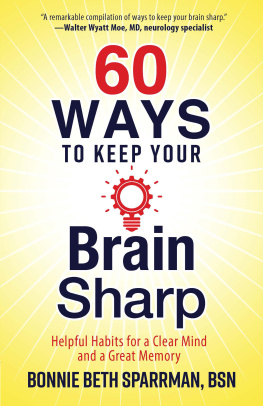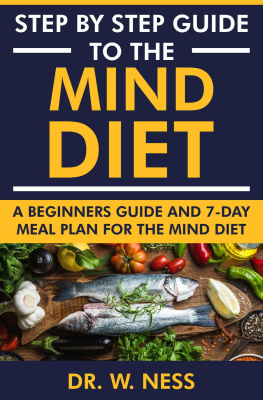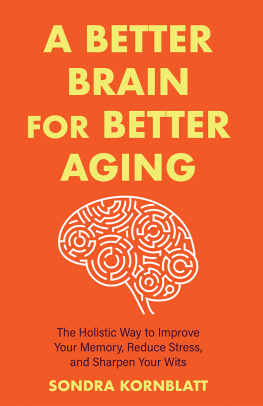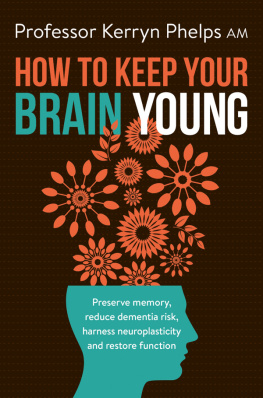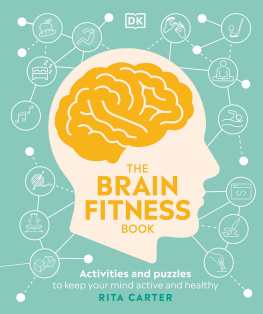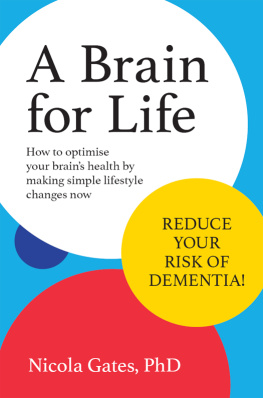

HARVEST HOUSE PUBLISHERS
EUGENE, OREGON
Unless otherwise indicated, all Scripture quotations are taken from the Holy Bible, New International Version, NIV. Copyright 1973, 1978, 1984, 2011 by Biblica, Inc. Used by permission. All rights reserved worldwide.
Verses marked NLT are taken from the Holy Bible , New Living Translation, copyright 1996, 2004, 2007, 2013 by Tyndale House Foundation. Used by permission of Tyndale House Publishers, Inc., Carol Stream, Illinois 60188. All rights reserved.
Cover by Bryce Williamson
Cover image chatchaisurakram / iStock
Back cover author photo by Christopher Erickson
All oven temperatures are given in degrees Fahrenheit.
60 WAYS TO KEEP YOUR BRAIN SHARP
Copyright 2018 by Bonnie Beth Sparrman
Published by Harvest House Publishers
Eugene, Oregon 97408
www.harvesthousepublishers.com
ISBN 978-0-7369-7209-3 (pbk.)
ISBN 978-0-7369-7210-9 (eBook)
Library of Congress Cataloging-in-Publication Data
Names: Sparrman, Bonnie Beth, author.
Title: 60 ways to keep your brain sharp / Bonnie Beth Sparrman.
Other titles: Sixty ways to keep your brain sharp
Description: Eugene, Oregon: Harvest House Publishers, [2018]
Identifiers: LCCN 2017035967 (print) | LCCN 2017036347 (ebook) | ISBN 9780736972109 (ebook) | ISBN 9780736972093 (pbk.)
Subjects: LCSH: BrainAgingPrevention. | BrainCare and hygiene. | BrainDiseasesNutritional aspects. | Mental health. | Self-care, Health.
Classification: LCC QP376 (ebook) | LCC QP376 .S737 2018 (print) | DDC 612.8/2dc23
LC record available at https://lccn.loc.gov/2017035967
All rights reserved. No part of this electronic publication may be reproduced, stored in a retrieval system, distributed, or transmitted in any form or by any meanselectronic, mechanical, digital, photocopy, recording, or any otherwithout the prior written permission of the publisher. The authorized purchaser has been granted a nontransferable, nonexclusive, and noncommercial right to access and view this electronic publication, and purchaser agrees to do so only in accordance with the terms of use under which it was purchased or transmitted. Participation in or encouragement of piracy of copyrighted materials in violation of authors and publishers rights is strictly prohibited.
For my husband, Eric,
whose constant love is my delight,
and for my father, Bendt Bladel,
whose perseverance is my inspiration.
Writing is a funny thing; it is done mostly in isolation but not without a lot of help from others. I have been abundantly blessed by many who have generously offered inspiration, ideas, prayers, and encouragement. First of all, Im extremely grateful for the sage advice of author and editor Todd Hafer. I owe many thanks to Todd for giving me this opportunity to write. Without his talent and trust, this book would not be. Also, I am thankful for Kim Moore, a seasoned editor, for her kindness and for her wise way with words.
I am also deeply indebted to my older friends who are stellar examples of vibrant brain health. First, I think of my dad, Bendt, who at 89 is sharp, athletic, persevering, and not afraid to learn new things. I am grateful for the way he lives, for his good genes, his enduring love, and for choosing a fabulous wife. He and my mother, Elaine, whom we lost to cancer way too early, looked beyond themselves with genuine interest in people of all ages.
Others who inspired this book include Stig Benson, Bonnie Abrahamson, Ken Vogel, Adaline Bjorkman, Harriet Lonergan, Ruth Petersen, Ginny Graham, Helen Pattie, Ingrid Bergstrom, Jack and Joan Streed, John and Mary Anderson, Bill and Jean Bristow, Dr. Wyatt and Nancy Moe, Marvin Bjorlin, Aunt Susann Gustafson, and my loving parents-in-law, Paul and Gunnie Sparrman. Thank you all for living long lives so beautifully.
Who could embark on a writing project without dear friends and family members to cheer and encourage? I owe tremendous gratitude to my wonderful childrenJohanna, Bjorn, Karl-Jon, and Isaand to my supportive siblings, Krissy, Gordy, Randy, Julie, Jon, Randi, Lisa, and Jim.
And what an enormous gift to have a covey of friends who lift me up along the way. I am especially thankful for Shelley Frew (my faithful confidante and pen pal for life), Lora Gus Plude, sa Linbro, Helena Folcker, Joey Nytes, Barbara and Steven Swanson, Jane Frasier, Sue Beck, Dr. Linda Solie, Joy Larson, Linda Peterson, Kristina Krafthefer, Molly Braley, Nancy Stark, Paige Vandegrift, Dr. Karen Tamte, Tim and Cyd Johnson, and Nancy Nordenson. Your help in practical ways, and in allowing your life stories to intersect with mine, thrills my heart and spurs me on.
Lastly, and most poignantly, God has blessed me through my ever-abiding husband, Eric. His love, patience, faithful prayers, technical skills, and coffee roasting abilities keep the journey light, exciting, and full of joy! It is my dream that together he and I will be riding our bikes to the bakery for decades to come. Honey, I owe you more than pain au chocolat !
Contents

F rom the vastness of the Milky Way to the grandeur of oceans and mountain ranges, and all the way down to the tiny legs of honeybees, Gods handiwork is magnificent. Yet, as we contemplate the breadth of creation, its not an exaggeration to say that the human brain is Gods masterpiece. Consider this: Every movement, every heartfelt pang, and every wild idea originates in our bodys mission-control center, the brain. This three-pound mass of firm jelly sitting between our ears is so important that God surrounded it with a protective, built-in helmet called the cranium.
As a nursing student, I was fascinated to discover that our miraculous brains are a forest of more than 100 billion nerve cells linked at more than 100 trillion points. Signals fly faster than the blink of an eye through this forest, forming the basis of memories, thoughts, and feelings. Within each persons gray matter lies the unique code that makes us who we are. Electrical impulses whiz through the labyrinth, determining our personality, temperament, and values, as well as our ability to see, move, hear, taste, smell, reason, create, believe, solve problems, and be in relationship with others. Without your amazing brain, you would not be you.
Because our brains make up the very essence of who we are, we need them to function well throughout our entire lifespan. We enter the world as helpless infants, dependent on others for our survival. Through love and nurturing care, we master baby skills and become toddlers who pull ourselves up to stand, walk, and then run circles around our parents legs. We scamper through childhood, limbs elongating and minds growing. Then, for better or for worse, another metamorphosis takes place. Children become teenagers. Eventually, they grow into young adults. All the while, brains are developing on myriad levels.
Fluid intelligence, the ability to logically solve problems, develops with us. Crystalized intelligence, which lets us apply our knowledge and experience, also expands as we mature to adulthood. And then what happens to our capacity to think?
You might have heard devastating reports that brainpower peaks at 18 and, following that auspicious age, we suffer a depressing decline. This is not completely true. Thanks to a couple of bright MIT researchers, Hartshorne and Germine, who have studied the brain function of 50,000 participants, we now know that different cognitive skills peak at various points along lifes journey.
Next page
